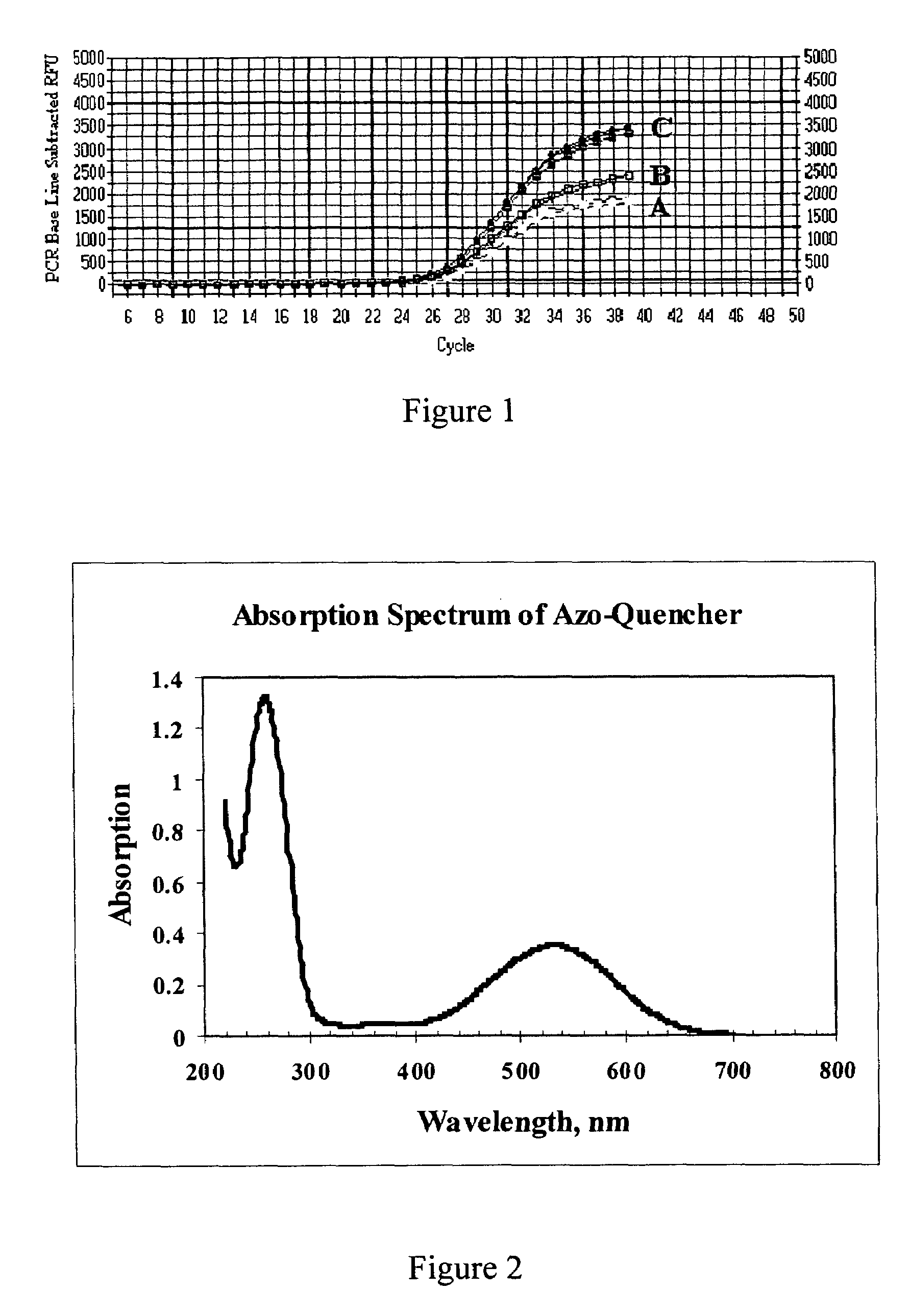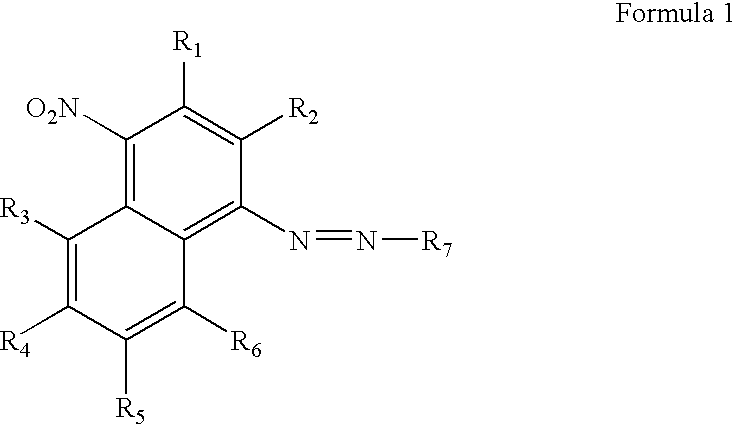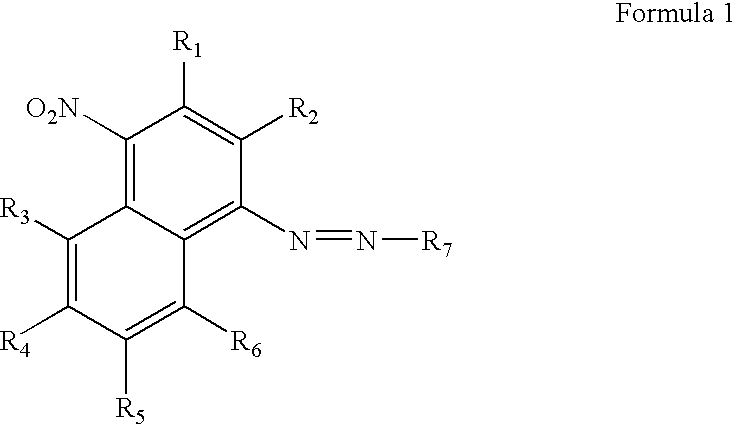Fluorescence quenching azo dyes, their methods of preparation and use
a technology of azo dyes and quenching azo, applied in the field of fluorescence quenching azo dyes, their methods of preparation and use, can solve the problems of increasing the distance between the donor and the quencher, complicating the design of probes that utilize frets, and increasing the fluorescent signal of the donor, so as to facilitate the conjugation
- Summary
- Abstract
- Description
- Claims
- Application Information
AI Technical Summary
Benefits of technology
Problems solved by technology
Method used
Image
Examples
example 1
[0056]This example demonstrates the chemical synthesis of the compound of Formula 9. The abbreviation “CEP” in the formula stands for cyanoethylphosphoramidite.
[0057]
[0058]The synthesis was as shown in Scheme 1 below. Cold concentrated HCl (4.25 mL) was added to a suspension of 4-nitro-1-naphthylamine (0.5 g, 2.66 mmol) in water (1.6 mL) at 0° C. A solution of NaNO2 (0.4 g) in water (1 mL) was added dropwise at 0° C. over 15 min and the 4-nitro-1-naphthylamine dissolved upon stirring. The solution was allowed to react for 10 min and then urea (0.16 g) was slowly added. Next, a solution of N-ethyl-N-hydroxyethylaniline (0.45 g) in acetic acid (2.18 mL) was mixed into the solution. After 15 mins, sodium acetate (5.31 g) in water (13.3 mL) was added slowly. The reaction mixture was stirred for 1 h at room temperature and the aqueous layer was then extracted twice with ethyl acetate. The organic layer was dried over Na2SO4 and subjected to flash chromatography with ethylacetate to give ...
example 2
[0062]This example demonstrates the synthesis of a controlled pore glass (CPG) support for oligonucleotide synthesis that is derivatized with a quencher of the present invention. The synthetic method is shown below in Schemes 2 and 3.
[0063]Mono-DMT-phenyl diethanolamine: A solution of 10 g of phenyl diethanolamine in 100 mL of pyridine was mixed for 3-4 h at room temperature with a solution of 6 g dimethoxytrityl-chloride (DMT-Cl) in 150 mL of a 98:2 dichloromethane / pyridine solution. The reaction mixture was concentrated to dryness under vacuum. The residue was dissolved in 200 mL of ethyl acetate, washed with two portions of 100 mL of deionized water, and the organic layer dried over Na2SO4. The organic solution was concentrated and purified by column chromatography using a 300 g of silica gel column developed with 30 / 65 / 5 ethyl acetate / hexanes / triethylamine to yield 5.25 g (20% yield) of mono-DMT-phenyl diethanolamine. TLC: Rf 0.55 (EtAc / hexanes / Et3N-40 / 55 / 5). 1H NMR (CDCl3)δ 7.3...
example 3
[0071]This example demonstrates the signal to noise ratio (S:N) ratio of oligonucleotides containing both fluorescein and the azo quencher as prepared in Examples 1 and 2. The method involved measuring the relative fluorescence of the oligonucleotide while it was in a native single stranded configuration (background fluorescence or “noise”) and comparing that with the fluorescence of the oligonucleotide measured when fluorophore and quencher are more separated (“signal”), as when the oligonucleotide is cleaved to separate the azo-quencher moiety from the fluorophore.
[0072]Oligonucleotide Synthesis. Dual-labeled oligonucleotides were made with the azo-quencher at either the 5′-end or 3′-end of the molecule and with the fluorescein reporter group placed at the opposing end (6-FAM, single isomer 6-carboxyfluorescein, Glen Research, Sterling, Va.). For comparison, an oligonucleotide was made that incorporated a commercially available quenching group, the Black Hole Quencher™-2 group (Bi...
PUM
| Property | Measurement | Unit |
|---|---|---|
| wavelength range | aaaaa | aaaaa |
| wavelength range | aaaaa | aaaaa |
| wavelength range | aaaaa | aaaaa |
Abstract
Description
Claims
Application Information
 Login to View More
Login to View More - R&D
- Intellectual Property
- Life Sciences
- Materials
- Tech Scout
- Unparalleled Data Quality
- Higher Quality Content
- 60% Fewer Hallucinations
Browse by: Latest US Patents, China's latest patents, Technical Efficacy Thesaurus, Application Domain, Technology Topic, Popular Technical Reports.
© 2025 PatSnap. All rights reserved.Legal|Privacy policy|Modern Slavery Act Transparency Statement|Sitemap|About US| Contact US: help@patsnap.com



